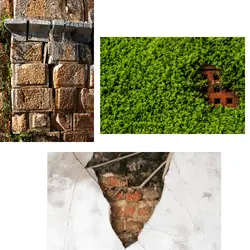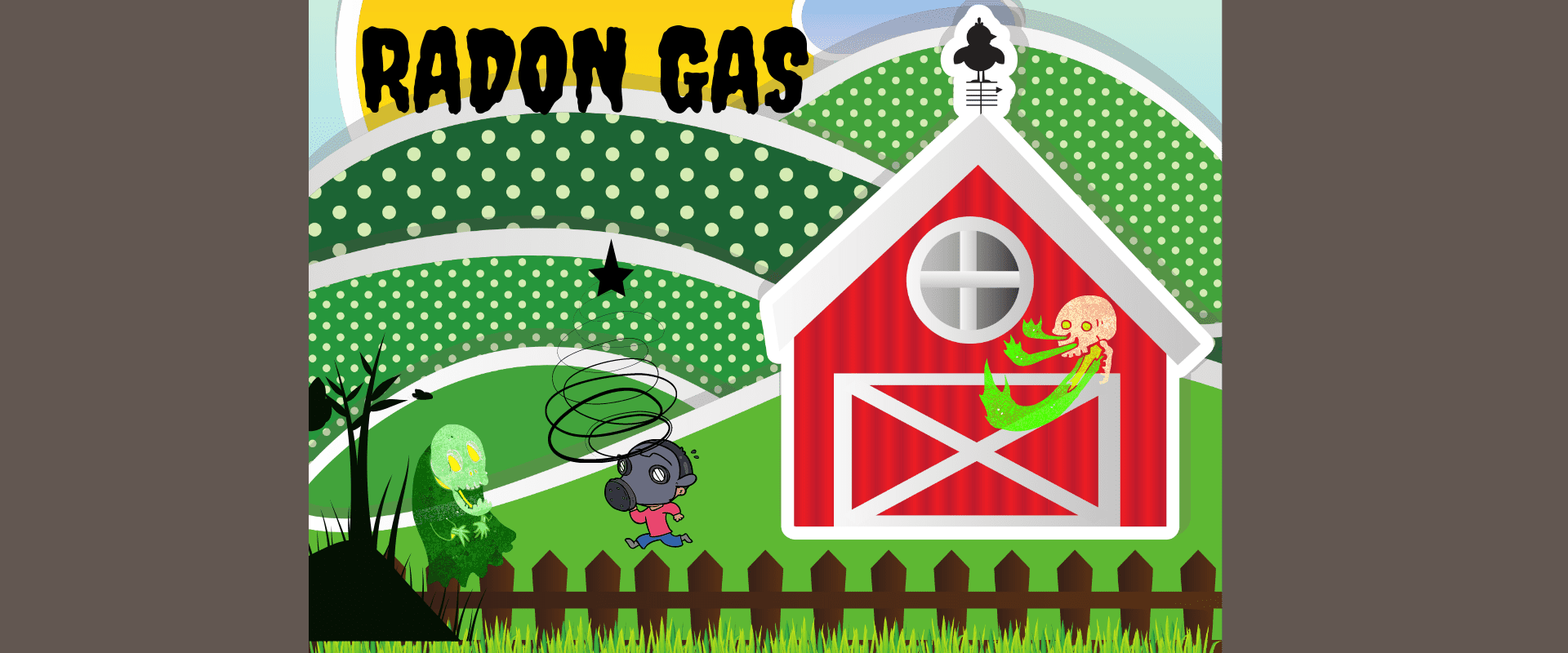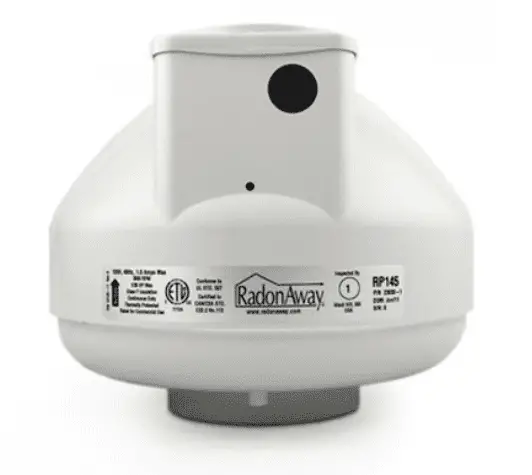Radon is a colourless, odourless and tasteless radioactive gas. It’s formed by the radioactive decay of small amounts of uranium that occur naturally in all rocks and soils, but it’s important to be aware of it and understand the side effects of Radon Gas.
Updated for 2022
The main danger from high radon exposure is the increased risk of lung cancer. For most people, radon is the single largest source of radiation exposure and is most intense in buildings whether at home or at work.
Radon occurs as naturally as oxygen and is common but harmful to your health. In larger quantities where it cannot be dispersed naturally into the atmosphere it can be potentially deadly.
How does it affect you (video)
Discover in this short video how Radon exposure might affect you and what you can do to identify and control the exposure.
Radon is found all over the United Kingdom, United States, Canada and many other places around the globe, but some areas have higher levels than others.
For example, large accumulations are known in the South West of England, The Pennines and the Cotswolds. Other areas around the country include Aberdeenshire in Scotland, areas of Northern Ireland and large sporadic patches in Wales.
Long Term Test Kit Example
As explained in the video, start off by checking the interactive maps to see if there is evidence of Radon in the area that you live or work.
If you suspect Radon is present then you need to know whether it is finding its way into your home or workplace and to what level.
This is where the passive long term test kit is useful. They are relatively inexpensive to buy and you don’t need any specialist knowledge to gather the information.
Simply order the test kit online (the example above is from Amazon). It comes with a pre-paid return envelope. Simply unwrap it, place it in your living or working space and leave it to absorb the atmosphere.
After the recommended period (usually 3-months), pop it into the pre-paid bag and return it to the test lab who will analyse the results and give you a report.
Depending on the results, you can breath a sigh of relief as it’s not a problem, or you can take some simple steps to control the problem.
See article >>> 5 Top Tips for Controlling Radon Gas In Your Home.
Areas Can Be Viewed Via The Links Below.



Like many other gases and elements Radon occurs naturally, and in most cases causes no more threat to humans than anything else we might come across on a day-to day basis.
However, when radon enters a building where it cannot disperse as easily, it may build up to levels that can trigger lung cancer over a period of time.
How do you become exposed to Radon Gas?
You’re exposed to radon when you breathe it in and radon gas may be found anywhere, including your workplace, your home, a school, or any other building for that matter.
As most people spend the most time in their homes, that’s where you are most likely to be at risk if you are in a radon prone area.

Radon migrates up through the ground and can seep into a building through cracks in the foundation or floor slab.
Once it seeps its way in, it can become trapped and accumulate, where it can build up to potentially fatal levels.
It can also get into your home by bubbling up through well water, and on rare occasions building materials have been found to release radon into a property.
Radon exposure and build up can happen in any type of property, but it’s more likely to accumulate in homes that are well insulated and/or tightly sealed as there is less chance of natural dispersion, and of course where the soil contains a natural concentration of uranium, thorium, and radium.
The higher the property goes, the less chance of radon throughout the building, and most concentrations are found to be in basements, floor voids and at the lower levels.
As discussed, Radon has no colour or smell. There is absolutely nothing to alert you to any threat of danger and it is one of the highest causes of lung cancer worldwide. The only way to be aware of it is to use a Radon Gas Monitor.
How do you protect yourself from Radon?
Radon. What can I do (video)
This short Public Health video goes further into what you can do if you find you are exposed to Radon. The interactive maps mentioned in the video are in the links above (country flags)
5 -Top Tips to Reduce Radon in Your Home

Radon is potentially everywhere. It is a naturally occurring radioactive gas that is produced from the decay of radioactive elements – such as uranium – in the earth’s rocks and soil. Radon gas contaminates both the ground and well water.
For most people, the risk of radon exposure usually comes from where they live and depends on several factors.
a). The amount of uranium found in rocks and the soil beneath the building.
b). Entry points for radon to enter the home such as cracks between concrete (usually found in the floor-to-wall junctions).
C). Gaps in tiles or the floor, small pores found in hollow-block walls, drains, and sump-pumps.
d). The air exchange rate between indoor and outdoor. Homes that are always sealed (a common occurrence in climates that are cold or hot year-round) have a much slower air exchange and tend to have higher levels of radon gas. A regular airing out of a home allows outside air to dilute the concentration.
e). Homes with poor ventilation (i.e tightly sealed), or homes that are poorly sealed at ground level.
What can you do if your home has high levels of Radon detected?
A radon level of 4 picoCuries per liter (pCi/L) or more is considered high.
Most of the time, you can reduce radon without making major home renovations or spending a lot of money.
If you don’t like DIY or don’t trust your skills, then you can employ a specialist Radon consultant or builder. Simply Google Radon Specialist + your area to see who is about.
As usual, before employing anybody to carry out works on your home or premises, carry out your due diligence and ask for referrals and other examples of where they have successfully carried out Radon remedial works.
What can you do yourself?

Seal cracks and gaps around the foundations of the property, and clear any obstructions from floor void vents such as weeds, dirt or diy attempts to block them up.
The purpose is to not only prevent Radon gas from seeping in, but to maintain the natural or designed air flow of the building to both help reduce the amount of radon that can enter and prevent it from accumulating underneath floor boards or in floor voids.
Professional or more advanced DIY fixes.
Install a Radon reduction system, which is essentially a vent pipe underneath the property attached to a continuously running extract fan. You could even mount one in the loft to provide a positive air pressure throughout the home to push Radon gas out of the property so that it harmlessly disperses to atmosphere.
A three- or four-inch pipe pulls radon from underneath the house and vents it outside. Or in the case of a loft mounted fan air is continually trickled through ceiling vents to create a gentle air pressure inside the property which pushes any gas gently out through doors, windows and natural vent points.
Create a gas-permeable layer beneath the slab or flooring with a plastic sheet on top. This allows radon to move under premises and out into the atmosphere. However, it can only be effective if you have a slab type foundation. It’s not for properties with a crawl space or floor void.
Conclusion
The only safe level of Radon gas to be exposed to is no level.
While no level of radon gas is completely safe, as with most things in life a balance and a certain amount of putting things into perspective must be met.
Often we will expose ourselves to high levels of radiation from the sun, despite being well educated on the risks of skin cancer.
We will eat foods, consume drinks and take substances such as nicotine which can have a similar effect.
And of course every time we step out of the door there is a risk of serious injury or death from road accidents and such like.
That said, with many of these examples we have a degree of choice, whereas you have no choice but to breathe the air in your immediate environment.
Be informed
Being informed is so important as with the correct information you can mitigate the risk, but only if you know where the risk exists and what you can practicably do about it.
Look at the maps in the links to first see if you are in a Radon risk area and watch the videos produced by the very informative UK Radon website (https://www.ukradon.org)
Most important is not to panic if you feel you are exposed. There is plenty of help to tackle Radon issues which is freely available and well documented.
As usual, please feel free to provide any comments or share your experiences below.
We would love to hear from people who have Radon experience and have practical advice for living with the threat.


Hey there! Thanks for putting together this detailed guide about Radon Gas and how I can protect myself and family from it. I had no idea that it could be right under me and not know it. Do you have any radon maps for North America? There are a lot of mines and factories where I live and I would like to know if this is a threat to me by living here.
Thanks a lot,
Marlinda
Hi Marlinda,
Most governments and health experts are on to areas prone to Radon gas.
North America is such a big place that I would have thought it would be mapped by a county to county basis, so may be worth contacting your local health authority or do a Google search for Radon gas in the area where you live.
Mines and factories in an area are not really a cause of Radon gas release. It’s more to do with the rock formation and whether it is uranium based or has other properties that cause Radon formation.
Also, it is important to remember that being out and about in a Radon prone area will not cause you a problem as it just naturally disperses into the atmosphere. It only becomes a problem when trapped in a building such as the basement of a house and is breathed in over a long period of time.
Even then, it’s normally easy to release and vent out of the building.
I hope that makes things a little clearer for you.
Thanks for stopping by.
Paul
Wow I had no idea wad this Radon gas is before this, to think that when I studied in the UK I could potentially have gotten exposed to it just makes me shiver.
Really the problem is just that Radon is undetectable. Honestly I think that the government should hire experts to survey areas and sort of mark the Radon levels or something.
Although it’s great that you’ve provided some solutions to the problem, at least we can take matters into our own hands now.
Hi Lucas,
Where did you study?
By clicking on the images of the flags then it opens up a map. (The first one though you have to scroll to the bottom of the pdf that opens up)
I can tell you though if you were in a Radon prone area.
Radon is a gas that is naturally released from the ground and happens in a lot of the world.
Most governments and health experts are on to it, but you just need to know if it affects where you live then you can take simple steps to protect yourself.
Thanks for reading.
Paul
wow I had never even heard of radon before your site. It’s wuite worrying to know that something as wide spread as this is out in abundance across the U.K. and no one is really talking about it. Thanks for the info, as I think that if it gets detected early then you have a better chance to deal with it through a specialist. I’ll be checking back on your site soon for more updates. Thanks Kenny
Hi Kenny,
Thanks for taking part in the discussion.
Radon Gas release is something people should be aware of, and it affects countries all over the world that have rock formations containing uranium and other properties.
Ordinarily it floats up harmlessly into the atmosphere, so walking around in a Radon prone area wouldn’t cause anybody any problems.
It’s only when the gas gets trapped in buildings because it can’t escape does it become a health issue, and that is over a long period of breathing it in.
People just need to be aware by contacting their local authority or searching on the internet to see if they are in an area affected.
Once they have that information then there are simple remedies for monitoring and releasing the gas.
Have a great day.
Paul
Wow I never gave Radon a thought!! I did not know how dangerous It can be!
Thankyou for your post in this and luckily being in Merseyside the map shows that they are low to no levels found in my area.
My house is always well ventilated even in winter as I can’t deal with the air after the central heating has been on so luckily if there is any it has a chance to disperse.
How did you find out about this ?
Hi Darren,
Yes, Merseyside and Cheshire are pretty much Radon free areas. Because you ventilate your home then it would unlikely be an issue to you anyway.
Ordinarily Radon floats away into the atmosphere harmlessly. It’s only when it becomes trapped and can’t escape that it becomes a health issue, and that’s over a long exposure period.
It’s certainly not a case of one whiff and your gone…
However, for those in affected areas then they need to be aware.
Thanks for reading.
Have a great day.
Paul
That only means tens of thousands of people are dying of lung cancer unknowing, the painful part is, the disease can be prevented.I don’t know why I haven’t heard of Radon gas, such a fatal gas.
This is a great article, I will share it with my friends whom I know have no even the slightest idea about this
Thank you so much
Yes, it has and still does affect thousands of people throughout the world, it’s not just confined to the UK.
Wherever the rock formation supports uranium and other certain properties then there is the potential for Radon Gas release.
Ordinarily, it’s not a problem to public health as it just drifts up and dilutes into the atmosphere. It only becomes a problem where buildings share the same ground and the Radon can potentially leak into the building and get trapped.
The remedies are simple but it’s a matter of doing some research to see if it’s a cause for concern where you live.
Thanks for stopping by and reading.
Paul
Thank you for this very informative post, I have never heard of random gas before and I am amazed at how dangerous it can become to our health. I have always been worried about things like Carbon monoxide, and now learning of another gas with such powerful impact on the human life. I was not able to figure a lot out from the map to know how safe my area is, as I live in the eastern part of London. Will have to check this out again when I get home, using my Laptop, as i find this information very useful and important. I will be back to have another look.
Hi Queen,
Radon gas is very common through many parts of the world, not just the UK.
If you live in a Radon gas prone area, it only becomes a long term health issue if it gets trapped in your house and there are simple ways to treat it.
Walking about is not a problem as it disperses naturally and harmlessly into the atmosphere.
To put your mind at ease though, East London is not particularly prone to it in any great quantities because the rock formation does not readily support the formation of Radon gas.
Check the map though and see for yourself, but it is easier on a PC rather than a phone.
Thanks for reading.
Paul